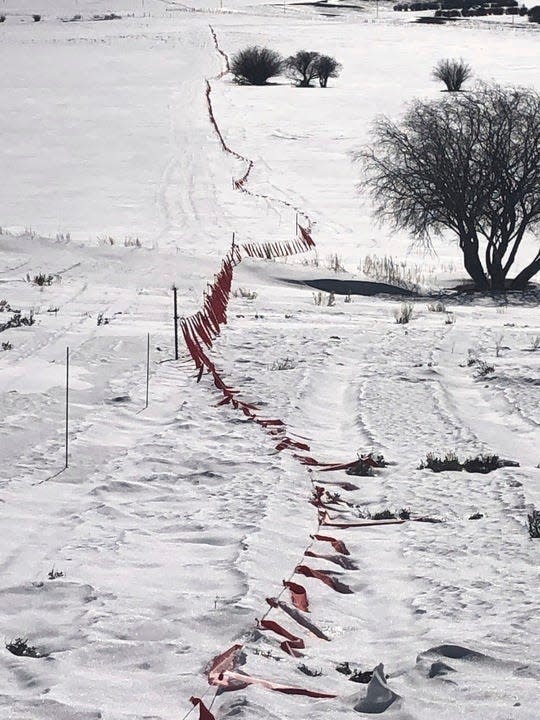Smith: Gray wolves will get new national recovery plan; more developments take place locally
As gray wolves in the Lower 48 states were protected and increased in number over the last 50 years, issues and developments regarding the species have also grown increasingly common.
Here are three from just the last week you ought to know about, two with larger implications outside of Wisconsin and one regarding state wolf hunting and trapping rules.
A new national plan could benefit wolves in California and the Northeast
Last Thursday the U.S. Fish and Wildlife Service announced it would draft a new recovery plan for gray wolves listed under the Endangered Species Act.
The move is part of a settlement with the Center for Biological Diversity; under the deal approved by a federal court, the draft plan must be completed within two years unless the agency finds "such a plan will not promote the conservation of the species."
While the species in Wisconsin and the Upper Peninsula of Michigan recovered naturally in recent decades as wolves dispersed from a core population in northeastern Minnesota, most other areas of its historical range in the U.S. remain unoccupied.
And the recovery plan for the Eastern wolf population was written in 1992 and is severely outdated, said Collette Adkins, Center for Biological Diversity's carnivore conservation program director and lead attorney on the case.
"A new national recovery plan should improve prospects for wolves in other areas," Adkins said. "We've been working to get a new, comprehensive plan to guide gray wolf recovery, so we feel this agreement is a win for wolves. We're excited that it will make (the USFWS) look across the nation."
The agreement follows an earlier court ruling that found the USFWS “must create a recovery plan for the species it has listed” and cannot rely on subspecies recovery plans that “straightforwardly do not satisfy” the Endangered Species Act.
While it's unclear how the process will turn out, Adkins said it could benefit wolves in California, Colorado and the Northeast U.S., all areas without a current plan to guide their recovery.
As part of the process to develop a national wolf recovery plan, the USFWS said it would begin a process to gather interested parties to "foster the long-term conservation of wolves and address the concerns of varied communities."
The process will "include those who live with wolves and those who do not but want to know they have a place on the landscape"; it will be led by a mediator, Francine Madden of Constructive Conflict LLC, to begin a national conversation around gray wolves.
"By engaging Ms. Madden and her team, the Service intends to participate as one among equals with citizens, Tribes, states, environmental groups, livestock producers, hunters and other contributors in this national dialogue," the USFWS said in a statement. "This effort will help inform the Service’s policies and future rulemaking about wolves."
The announcement did not say when the group would first meet or who would be included.

Wolf restoration begins in Colorado
Wolf advocates cheered Monday for the release of five gray wolves in Grand County, Colorado, the official start of that state's wolf restoration project.
The wolves were captured in Oregon and released on state-owned land in Colorado; as many as five more could be brought to Colorado through March 2024, the first phase of a multi-year restoration campaign.
“This is an historic moment that makes me proud to be a Coloradan,” said Kaitie Schneider, Rockies and Plains representative at Defenders of Wildlife. “Living alongside wolves and other wildlife is part of life in the West, and we have the tools we need to successfully restore this piece of our natural heritage. Now, we must allow these wolves to lead us toward the first self-sustaining wolf population Colorado has seen in over 80 years.”
Colorado voters narrowly passed a 2020 ballot measure requiring its state wildlife agency to reintroduce gray wolves to the state. The agency had a Dec. 31 deadline to bring the first group of wolves to Colorado.
The released wolves are wearing GPS collars to help biologists track the animals. Colorado officials are negotiating with representatives of other states and tribal nations to determine where to source wolves for the remainder of the three- to five-year reintroduction process, a tactic that could enhance genetic diversity.
Wisconsin legislature reviews new Natural Resources board wolf hunt regulations
Here in Wisconsin, the Senate Committee on Financial Institutions and Sporting Heritage on Tuesday held a hearing on Clearinghouse Rule 23-047, or gray wolf harvest regulations.
The regulations were approved by the Natural Resources Board in October but are subject to legislative review.
The rules include a faster reporting requirement for wolf kills, a zone-specific tag system, protections for wolf dens and added restrictions in dog training on wolves.
Since the wolf in Wisconsin and most other states is currently under protections of the federal Endangered Species Act, preventing hunting, trapping and other lethal means of management, the new rules can't be implemented until the species is delisted. However, they must pass legislative review before they are finalized.
The Wisconsin Bear Hunters Association and George Meyer, representing himself, were among those who registered or testified in opposition to the rules.
If the Senate committee votes against the clearinghouse rule the proposal would next be considered by the Joint Committee for Review of Administrative Rules. If JCRAR and the Legislature move to reject the rules they would advance to Gov. Tony Evers for final consideration.
Stay tuned for action on this, and no doubt many other wolf-related items, in the new year.
This article originally appeared on Milwaukee Journal Sentinel: Gray wolves will get new national recovery plan
